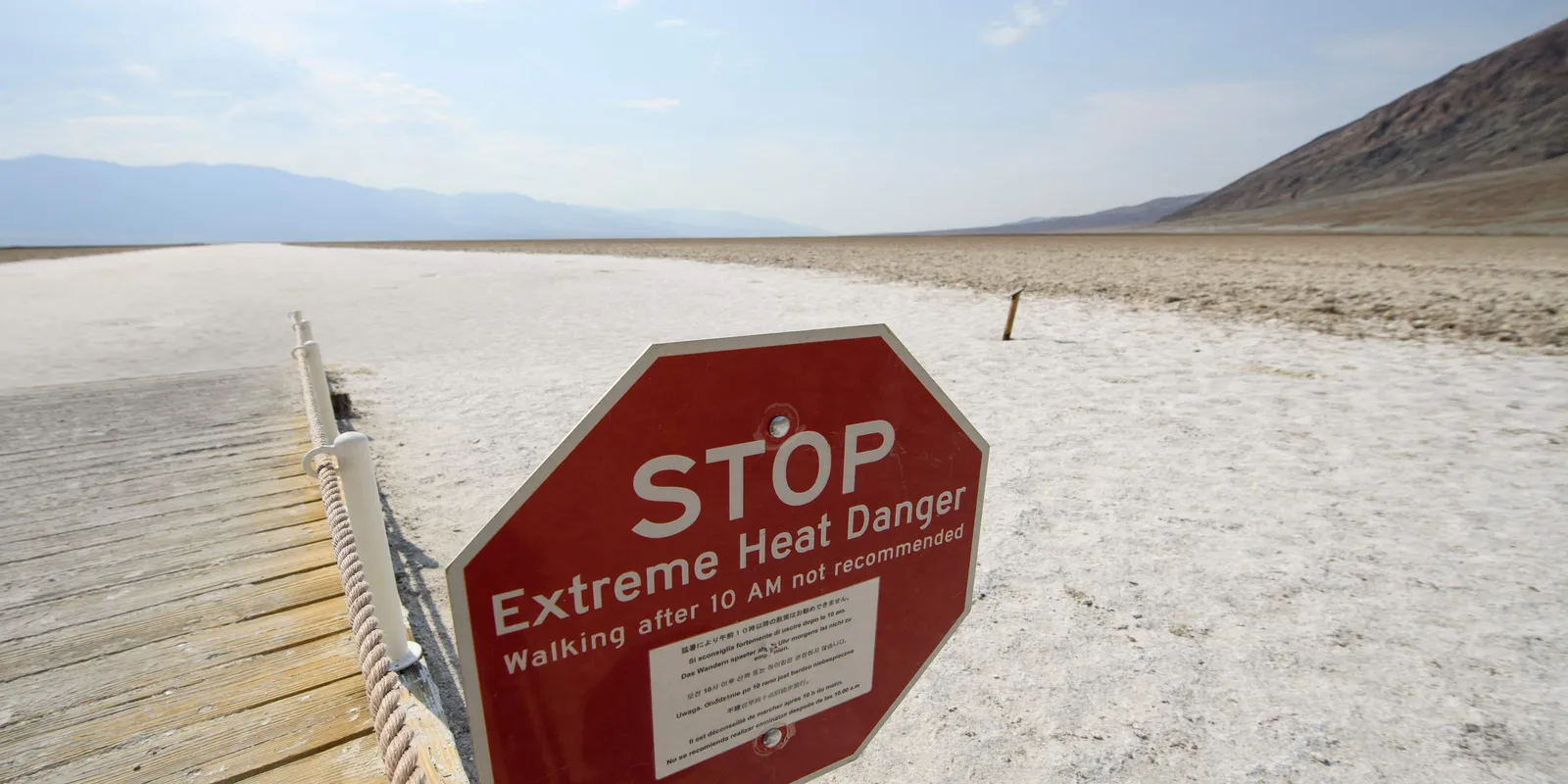Home>Health & Nutrition>Ups Drivers Sharing Photos Of Extreme Heat Inside Trucks Without Air Conditioning


Health & Nutrition
Ups Drivers Sharing Photos Of Extreme Heat Inside Trucks Without Air Conditioning
Published: March 3, 2024
Discover the impact of extreme heat inside UPS trucks on driver health and nutrition. Learn how to stay healthy in challenging work conditions.
(Many of the links in this article redirect to a specific reviewed product. Your purchase of these products through affiliate links helps to generate commission for Temperatures.com, at no extra cost. Learn more)
Table of Contents
The Dangers of Extreme Heat Inside UPS Trucks
The extreme heat inside UPS trucks poses significant risks to the health and safety of drivers. During the scorching summer months, these vehicles can become veritable ovens, reaching temperatures well above the outdoor ambient temperature. As a result, UPS drivers are exposed to prolonged periods of intense heat, which can have detrimental effects on their well-being.
Prolonged exposure to high temperatures can lead to heat-related illnesses such as heat exhaustion and heat stroke. These conditions can manifest as dizziness, nausea, rapid heartbeat, and in severe cases, loss of consciousness. The confined space of the delivery truck exacerbates these risks, as the heat becomes trapped inside, creating an environment that is both uncomfortable and potentially hazardous for the drivers.
Furthermore, the extreme heat can also impact the integrity of packages being transported, especially those containing perishable items or heat-sensitive materials. This not only jeopardizes the quality of the goods being delivered but also presents logistical challenges for the drivers as they strive to maintain the condition of the packages.
In addition to the physical dangers, the mental and emotional toll of working in such oppressive conditions should not be overlooked. The stress and discomfort resulting from prolonged exposure to extreme heat can contribute to driver fatigue and decreased concentration, potentially compromising their ability to operate their vehicles safely.
It is essential to recognize that the dangers of extreme heat inside UPS trucks extend beyond the immediate health risks to the drivers. The impact of these conditions can reverberate throughout the entire delivery process, affecting the quality of service provided to customers and the overall efficiency of UPS operations.
In light of these dangers, it is imperative to address the issue of extreme heat inside UPS trucks proactively. By acknowledging the risks and understanding the potential consequences, steps can be taken to mitigate the impact of high temperatures on the well-being of UPS drivers and the integrity of the packages they handle.
Impact on UPS Drivers' Health and Safety
The relentless exposure to extreme heat inside UPS trucks poses a myriad of challenges to the health and safety of the drivers. As the sweltering temperatures soar during the summer months, the interior of these delivery vehicles transforms into unforgiving environments, subjecting the drivers to a host of physical and mental health risks.
Prolonged exposure to high temperatures can lead to a range of heat-related illnesses, including heat exhaustion and heat stroke. These conditions can manifest in symptoms such as dizziness, nausea, rapid heartbeat, and in severe cases, loss of consciousness. The confined space of the delivery truck exacerbates these risks, as the heat becomes trapped inside, creating an environment that is both uncomfortable and potentially hazardous for the drivers.
Moreover, the demanding nature of the job requires UPS drivers to be alert and focused while navigating through various traffic conditions and delivering packages promptly. However, the oppressive heat can lead to fatigue and decreased concentration, impairing the drivers' ability to operate their vehicles safely. This not only jeopardizes their own well-being but also poses a risk to other road users and pedestrians.
The mental and emotional toll of working in such oppressive conditions should not be underestimated. The stress and discomfort resulting from prolonged exposure to extreme heat can contribute to heightened levels of anxiety and irritability among the drivers. This, in turn, can impact their overall job satisfaction and morale, potentially leading to decreased productivity and increased turnover rates within the workforce.
Furthermore, the impact of extreme heat extends beyond the immediate health risks to the drivers. The relentless exposure to high temperatures can also affect the integrity of the packages being transported. Perishable items and heat-sensitive materials are particularly vulnerable, raising concerns about the quality and safety of the goods being delivered to customers.
In essence, the impact of extreme heat on UPS drivers' health and safety is multifaceted, encompassing physical, mental, and emotional dimensions. Addressing these challenges is crucial not only for the well-being of the drivers but also for the overall efficiency and reliability of UPS operations. It is imperative to recognize the significance of mitigating the risks associated with extreme heat inside delivery trucks to ensure the health, safety, and job satisfaction of UPS drivers.
UPS's Response to the Issue
In response to the pressing concerns surrounding the extreme heat inside UPS trucks, the company has taken proactive measures to address the challenges faced by its drivers. Recognizing the critical importance of ensuring the well-being and safety of its workforce, UPS has implemented various initiatives aimed at mitigating the impact of high temperatures within its delivery vehicles.
One of the key strategies employed by UPS involves the integration of advanced technology to monitor and regulate the internal temperature of its trucks. The company has invested in state-of-the-art cooling systems and thermal management solutions designed to maintain a comfortable and safe working environment for drivers, particularly during periods of intense heat. By leveraging innovative climate control mechanisms, UPS aims to minimize the risk of heat-related illnesses and enhance the overall working conditions for its employees.
Furthermore, UPS has prioritized comprehensive training and education programs focused on heat safety and awareness. Through these initiatives, drivers are equipped with the knowledge and resources necessary to recognize the signs of heat-related stress and take appropriate measures to safeguard their health. By fostering a culture of proactive heat management, UPS empowers its drivers to prioritize their well-being while executing their daily responsibilities.
In addition to technological advancements and training efforts, UPS has implemented revised scheduling and routing protocols to minimize the impact of extreme heat on its drivers. By optimizing delivery routes and adjusting operational timelines, the company seeks to reduce the duration of exposure to high temperatures, thereby mitigating the associated health risks. These strategic adjustments reflect UPS's commitment to prioritizing the safety and welfare of its workforce in the face of challenging environmental conditions.
Moreover, UPS has established clear communication channels and support systems to enable drivers to report concerns related to extreme heat promptly. By fostering an open and responsive organizational culture, the company ensures that drivers' feedback is acknowledged and acted upon effectively. This approach not only facilitates the identification of potential heat-related issues but also underscores UPS's dedication to addressing the well-being of its employees in a proactive and empathetic manner.
In essence, UPS's response to the issue of extreme heat inside its trucks underscores a comprehensive and multifaceted approach aimed at safeguarding the health and safety of its drivers. Through a combination of technological innovation, education, operational adjustments, and supportive infrastructure, UPS demonstrates a steadfast commitment to mitigating the impact of extreme heat on its workforce. By prioritizing the well-being of its employees, UPS sets a commendable example of proactive and responsible corporate stewardship in the face of environmental challenges.
Calls for Improved Working Conditions
The challenging working conditions faced by UPS drivers, particularly in relation to extreme heat inside delivery trucks, have prompted widespread calls for enhanced measures to ensure the well-being and safety of the workforce. The escalating concerns surrounding the impact of high temperatures on drivers' health and job satisfaction have catalyzed a compelling demand for comprehensive improvements in working conditions within the logistics industry.
At the forefront of these calls is a resounding plea for heightened investment in advanced cooling and climate control systems within UPS trucks. The integration of cutting-edge technologies designed to regulate and maintain optimal temperatures can significantly mitigate the risks associated with extreme heat, fostering a more comfortable and secure working environment for drivers. By prioritizing the implementation of state-of-the-art cooling solutions, UPS can proactively address the challenges posed by oppressive heat and demonstrate a steadfast commitment to the well-being of its employees.
Furthermore, there is a compelling need for the establishment of stringent regulatory standards and guidelines pertaining to heat safety in the workplace. By formalizing comprehensive protocols for managing extreme heat conditions, UPS and other logistics companies can ensure adherence to best practices that safeguard the health and safety of drivers. Clear and enforceable regulations serve as a crucial foundation for promoting a culture of accountability and responsibility, ultimately fostering improved working conditions for all employees.
In addition to technological and regulatory enhancements, there is a growing consensus on the importance of fostering a supportive and empathetic organizational culture within UPS. Calls for enhanced communication channels, responsive feedback mechanisms, and proactive support systems underscore the significance of prioritizing the well-being of drivers. By nurturing a workplace environment that values and addresses the concerns of its employees, UPS can cultivate a sense of trust, loyalty, and mutual respect, thereby enhancing overall job satisfaction and morale.
Moreover, the advocacy for improved working conditions extends to the realm of comprehensive training and education programs focused on heat safety and stress management. By equipping drivers with the knowledge, resources, and skills necessary to navigate challenging environmental conditions, UPS can empower its workforce to proactively mitigate the impact of extreme heat. Investing in ongoing training initiatives reflects a commitment to the professional development and welfare of employees, ultimately contributing to a more resilient and adaptable workforce.
In essence, the resounding calls for improved working conditions within UPS reflect a collective commitment to prioritizing the well-being, safety, and job satisfaction of drivers. By advocating for technological innovation, regulatory standards, supportive organizational culture, and comprehensive training, stakeholders underscore the imperative of fostering an environment that values and safeguards the welfare of its workforce. These calls serve as a compelling catalyst for transformative change, inspiring UPS to embrace proactive and holistic measures that elevate working conditions and uphold the dignity and resilience of its employees.
Potential Solutions for UPS Drivers
Addressing the challenges posed by extreme heat inside UPS trucks necessitates the exploration of multifaceted solutions aimed at safeguarding the well-being and safety of the drivers. By prioritizing proactive measures and innovative strategies, UPS can mitigate the impact of high temperatures and foster a more conducive working environment for its workforce.
One pivotal solution involves the integration of advanced cooling and climate control systems within UPS trucks. By leveraging cutting-edge technologies designed to regulate and maintain optimal temperatures, the company can significantly reduce the risk of heat-related illnesses and discomfort for drivers. Implementing robust cooling mechanisms not only enhances the working conditions within the vehicles but also underscores UPS's commitment to prioritizing the health and safety of its employees.
Furthermore, the establishment of comprehensive regulatory standards and guidelines pertaining to heat safety is paramount. By formalizing clear protocols for managing extreme heat conditions, UPS can ensure adherence to best practices that safeguard the well-being of its drivers. Enforceable regulations serve as a crucial foundation for promoting a culture of accountability and responsibility, ultimately fostering improved working conditions for all employees.
In addition to technological and regulatory enhancements, fostering a supportive and empathetic organizational culture within UPS is essential. By enhancing communication channels, responsive feedback mechanisms, and proactive support systems, the company can cultivate an environment that values and addresses the concerns of its employees. Nurturing a workplace culture that prioritizes the well-being of drivers contributes to enhanced job satisfaction, morale, and overall employee retention.
Comprehensive training and education programs focused on heat safety and stress management are equally vital. By equipping drivers with the knowledge, resources, and skills necessary to navigate challenging environmental conditions, UPS empowers its workforce to proactively mitigate the impact of extreme heat. Investing in ongoing training initiatives reflects a commitment to the professional development and welfare of employees, ultimately contributing to a more resilient and adaptable workforce.
In essence, the potential solutions for UPS drivers underscore a holistic and proactive approach aimed at safeguarding the well-being and safety of the workforce. By advocating for technological innovation, regulatory standards, supportive organizational culture, and comprehensive training, UPS can elevate working conditions and uphold the dignity and resilience of its employees. These solutions serve as a compelling catalyst for transformative change, inspiring UPS to embrace proactive measures that prioritize the welfare of its workforce.















